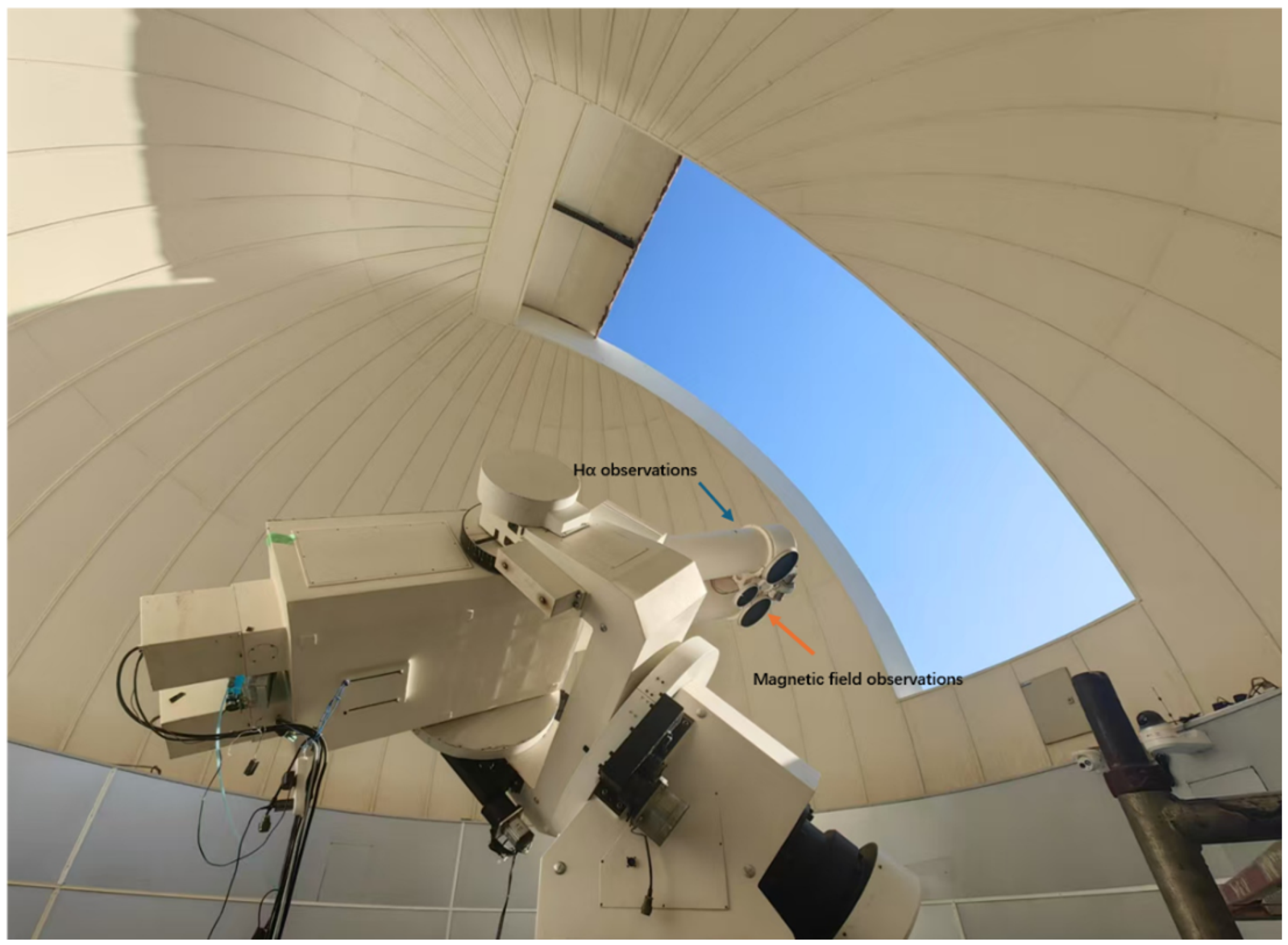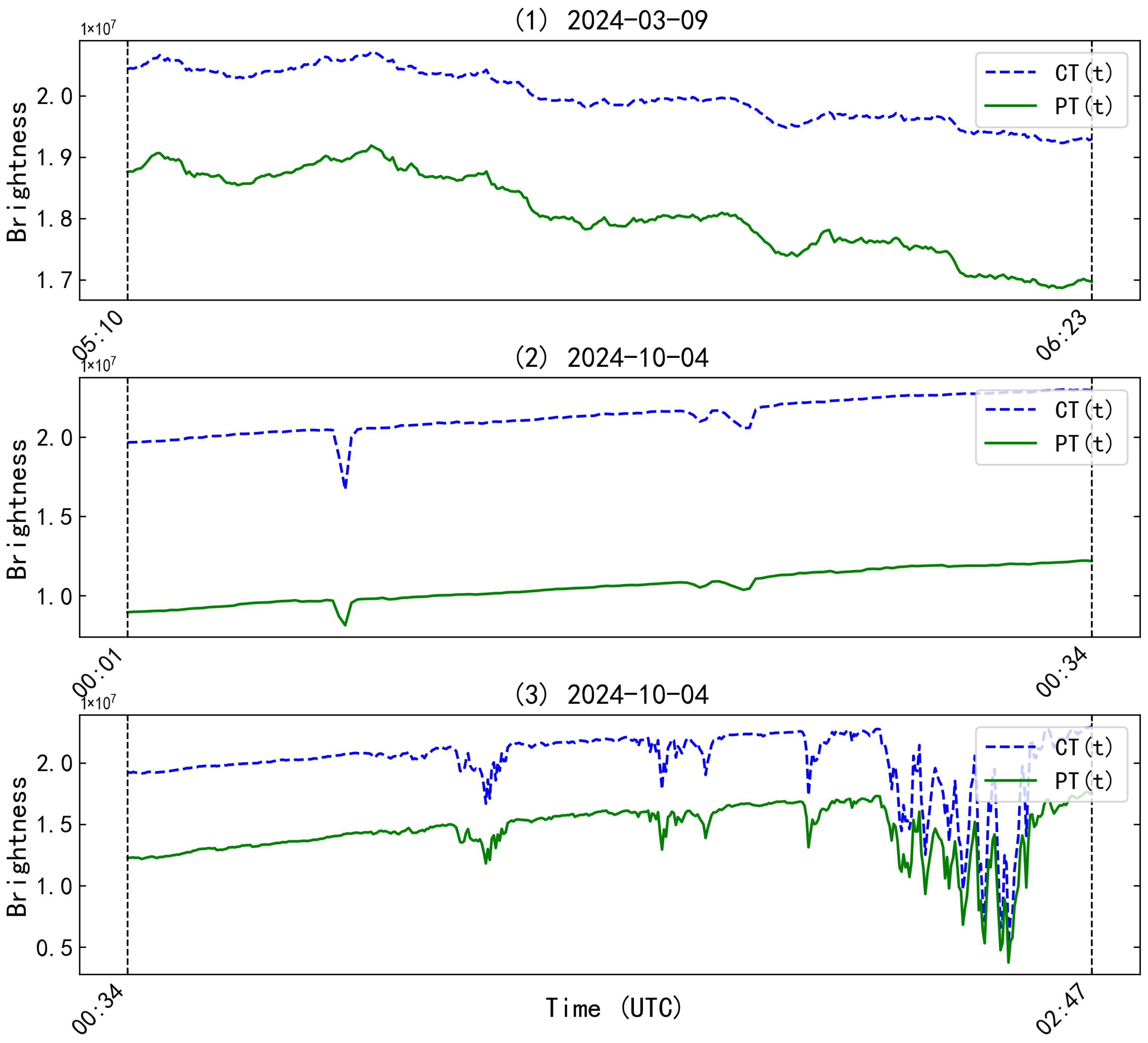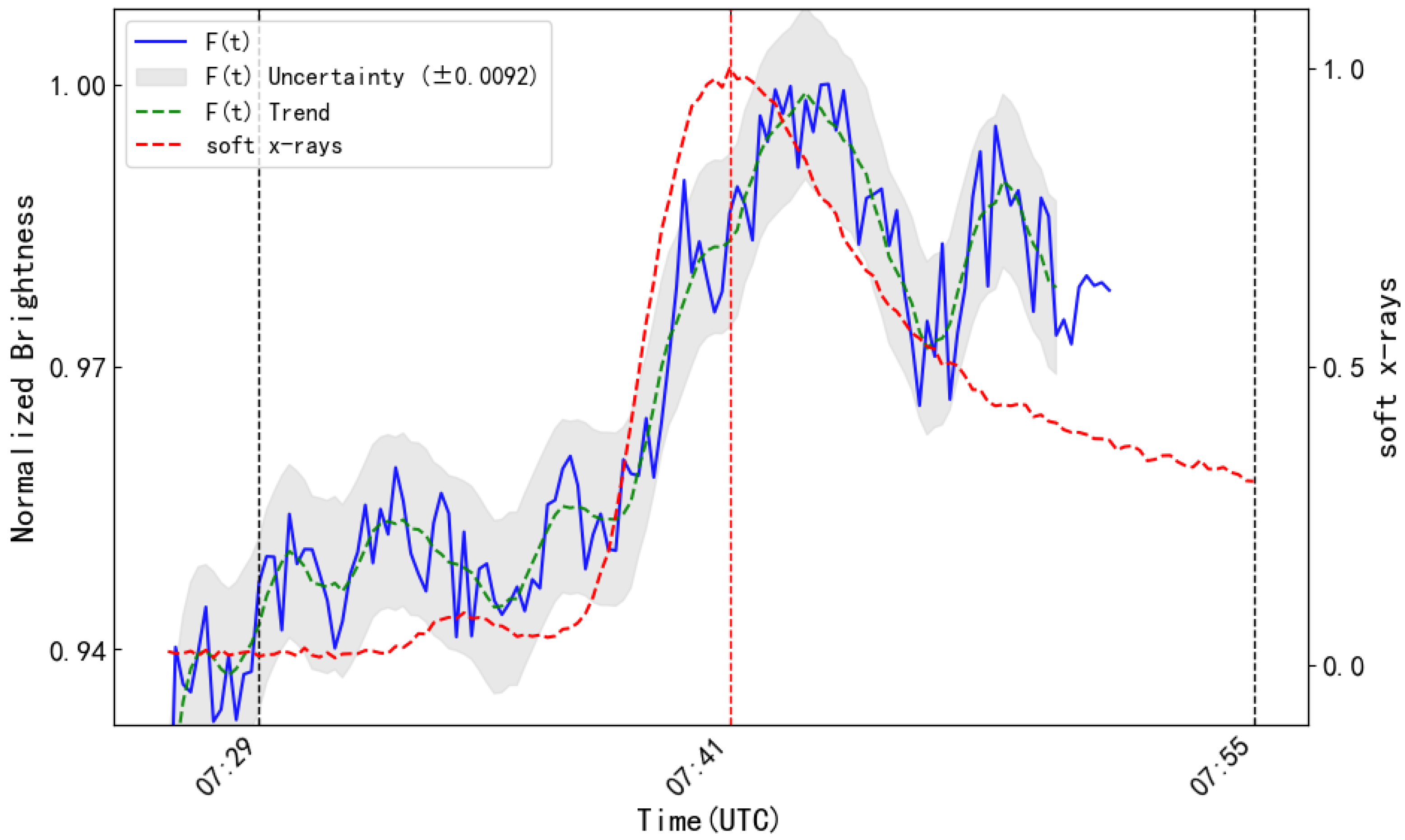Research on Removing Thin Cloud Interference in Solar Flare Monitoring with SMAT-Configured Telescopes
Abstract
1. Introduction
2. Data
2.1. Instruments
2.2. Data Preprocess
- Convert the image data into grayscale images.
- Align the images using correlation.
- Extract the flare-occurring regions from the photospheric and chromospheric images (with the same extraction area).
3. Methods
Methods for Removing the Influence of Thin Clouds on SMAT
4. Results
Validation of SMAT Observed Data
5. Conclusions and Discussion
Author Contributions
Funding
Data Availability Statement
Acknowledgments
Conflicts of Interest
References
- Schrijver, C.J.; Kauristie, K.; Aylward, A.D.; Denardini, C.M.; Gibson, S.E.; Glover, A.; Gopalswamy, N.; Grande, M.; Hapgood, M.; Heynderickx, D.; et al. Understanding space weather to shield society: A global road map for 2015–2025 commissioned by COSPAR and ILWS. Adv. Space Res. 2015, 55, 2745–2807. [Google Scholar] [CrossRef]
- Janssen, M. On the solar protuberances. Proc. R. Soc. Lond. 1868, 17, 276–277. [Google Scholar] [CrossRef]
- Lockyer, J.N.; Frankland, P.F. Preliminary note of researches on gaseous spectra in relation to the physical constitution of the sun. Proc. R. Soc. Lond. 1869, 17, 350–356. [Google Scholar] [CrossRef]
- Rimmele, T.R.; Marino, J. Solar adaptive optics. Living Rev. Sol. Phys. 2011, 8, 2. [Google Scholar] [CrossRef] [PubMed]
- Xukun, Z.; Wei, S.; Ganghua, L.; Yuxi, S. Solar Image Cloud Removal based on Improved Pix2Pix Network. Comput. Mater. Contin. 2022, 73, 6181–6193. [Google Scholar] [CrossRef]
- Shen, X.; Li, Q.; Tian, Y.; Shen, L. An Uneven Illumination Correction Algorithm for Optical Remote Sensing Images Covered with Thin Clouds. Remote Sens. 2015, 7, 11848–11862. [Google Scholar] [CrossRef]
- Shen, H.; Li, H.; Qian, Y.; Zhang, L.; Yuan, Q. An effective thin cloud removal procedure for visible remote sensing images. ISPRS J. Photogramm. Remote Sens. 2014, 96, 224–235. [Google Scholar] [CrossRef]
- Yang, X.; Jia, Z.; Yang, J.; Kasabov, N. Change Detection of Optical Remote Sensing Image Disturbed by Thin Cloud Using Wavelet Coefficient Substitution Algorithm. Sensors 2019, 19, 1972. [Google Scholar] [CrossRef] [PubMed]
- Zi, Y.; Ding, H.; Xie, F.; Jiang, Z.; Song, X. Wavelet Integrated Convolutional Neural Network for Thin Cloud Removal in Remote Sensing Images. Remote Sens. 2023, 15, 781. [Google Scholar] [CrossRef]
- Lv, Z.; An, N.; Fan, C.; Zhang, H.; Zhao, G.; Song, Q.; Dong, H.; Liu, C. Automatic processing of satellite laser ranging data based on image denoising technique. Opt. Commun. 2024, 562, 130570. [Google Scholar] [CrossRef]
- Shibata, K.; Magara, T. Solar Flares: Magnetohydrodynamic Processes. Living Rev. Sol. Phys. 2011, 8, 6. [Google Scholar] [CrossRef]
- Fletcher, L.; Dennis, B.R.; Hudson, H.; Krucker, S.; Phillips, K.; Veronig, A.; Battaglia, M.; Bone, L.; Caspi, A.; Chen, Q.; et al. An Observational Overview of Solar Flares. Space Sci. Rev. 2011, 159, 19. [Google Scholar] [CrossRef]
- Neidig, D.F.; Wiborg, P.H.; Gilliam, L.B. Physical properties of white-light flares derived from their center-to-limb distribution. Sol. Phys. 1993, 144, 169–194. [Google Scholar] [CrossRef]
- Yongliang, S.; Hui, T. Investigation of White-light Emission in Circular-ribbon Flares. ApJ 2018, 867, 159. [Google Scholar] [CrossRef]
- Carrington, R.C. Description of a Singular Appearance seen in the Sun on 1 September 1859. Mon. Not. R. Astron. Soc. 1859, 20, 13–15. [Google Scholar] [CrossRef]
- Hodgson, R. On a curious Appearance seen in the Sun. Mon. Not. R. Astron. Soc. 1859, 20, 15–16. [Google Scholar] [CrossRef]
- Fang, C.; Chen, P.-F.; Li, Z.; Ding, M.-D.; Dai, Y.; Zhang, X.-Y.; Mao, W.-J.; Zhang, J.-P.; Li, T.; Liang, Y.-J. A new multi-wavelength solar telescope: Optical and Near-infrared Solar Eruption Tracer (ONSET). Res. Astron. Astrophys. 2013, 13, 1509. [Google Scholar] [CrossRef]
- Jing, Z.; Li, Y.; Feng, l.; Li, H.; Huang, Y.; Li, Y.; Su, Y.; Chen, W.; Tian, J.; Song, D.; et al. A Statistical Study of Solar White-Light Flares Observed by the White-light Solar Telescope of the Lyman-alpha Solar Telescope on the Advanced Space-based Solar Observatory (ASO-S/LST/WST) at 360 nm. Sol. Phys. 2024, 299, 11. [Google Scholar] [CrossRef]
- Smith, E.; Gottlieb, D. Solar flux and its variations. Space Sci. Rev. 1974, 16, 771–802. [Google Scholar] [CrossRef]
- Zhang, H.Q.; Wang, D.G.; Deng, Y.Y.; Hu, K.L.; Su, J.T.; Lin, J.B.; Lin, G.H.; Yang, S.M.; Mao, W.J.; Wang, Y.N.; et al. Solar Magnetism and the Activity Telescope at HSOS. Chin. J. Astron. Astrophys. 2007, 7, 281. [Google Scholar] [CrossRef]
- Wang, L.; Sun, Y. Improved Canny edge detection algorithm. In Proceedings of the 2021 2nd International Conference on Computer Science and Management Technology (ICCSMT), Shanghai, China, 12–14 November 2021; pp. 414–417. [Google Scholar] [CrossRef]
- Mukhopadhyay, P.; Chaudhuri, B.B. A survey of Hough Transform. Pattern Recognit. 2015, 48, 993–1010. [Google Scholar] [CrossRef]
- Veronig, A.; Vršnak, B.; Temmer, M.; Hanslmeier, A. Relative timing of solar flares observed at different wavelengths. Sol. Phys. 2002, 208, 297–315. [Google Scholar] [CrossRef]






| Case | Pearson r 1 | CC Lag 2 |
|---|---|---|
| (1) | 0.997 | 0 |
| (2) | 0.982 | 0 |
| (3) | 0.947 | 0 |
Disclaimer/Publisher’s Note: The statements, opinions and data contained in all publications are solely those of the individual author(s) and contributor(s) and not of MDPI and/or the editor(s). MDPI and/or the editor(s) disclaim responsibility for any injury to people or property resulting from any ideas, methods, instructions or products referred to in the content. |
© 2025 by the authors. Licensee MDPI, Basel, Switzerland. This article is an open access article distributed under the terms and conditions of the Creative Commons Attribution (CC BY) license (https://creativecommons.org/licenses/by/4.0/).
Share and Cite
Li, H.; Yang, S.; Hu, X.; Xu, H. Research on Removing Thin Cloud Interference in Solar Flare Monitoring with SMAT-Configured Telescopes. Universe 2025, 11, 282. https://doi.org/10.3390/universe11090282
Li H, Yang S, Hu X, Xu H. Research on Removing Thin Cloud Interference in Solar Flare Monitoring with SMAT-Configured Telescopes. Universe. 2025; 11(9):282. https://doi.org/10.3390/universe11090282
Chicago/Turabian StyleLi, Hongyan, Shangbin Yang, Xing Hu, and Haiqing Xu. 2025. "Research on Removing Thin Cloud Interference in Solar Flare Monitoring with SMAT-Configured Telescopes" Universe 11, no. 9: 282. https://doi.org/10.3390/universe11090282
APA StyleLi, H., Yang, S., Hu, X., & Xu, H. (2025). Research on Removing Thin Cloud Interference in Solar Flare Monitoring with SMAT-Configured Telescopes. Universe, 11(9), 282. https://doi.org/10.3390/universe11090282








